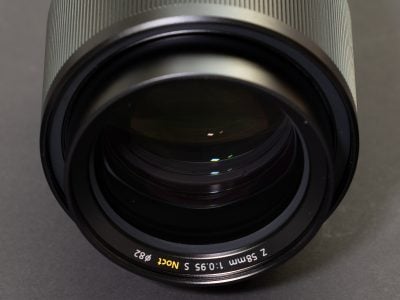Nikon Z 58mm f0.95 Noct review
-
-
Written by Thomas
Intro
The Nikon Z 58mm f0.95 S Noct is the second standard prime lens for Nikon’s full-frame Z-series mirrorless cameras. A popular focal length for street photography and general-purpose use, it features a unique f0.95 focal ratio gathering almost 4 times the light of its smaller sibling the Z 50mm f1.8 S, hence earning the famed “Noct” moniker. On a cropped body like the Z50 the new lens is equivalent in angle-of-view and depth-of-field to a 85mm f1.4 lens. This is quite attractive for portrait photography and gives good background isolation even on the smaller format sensor.
This lens has been teased since the launch of the Z system and finally demonstrates what is possible with the large diameter Z-mount. Be aware though that it offers only manual focus which should limit its use with moving subjects. But if you can nail focus the results should deliver Bokeh beyond what was possible before on a full-frame camera. Nikon also claims very low sagittal coma flare rendering point-light sources like stars sharp across the sensor. This unique specification comes at a high cost though, with an eye-watering price tag of 8999 EUR / 7999 USD.
I thoroughly tested the Z Noct on the 45MP Z7 body against Nikon’s own Z 50mm f1.8 S and AF-S 58mm f1.4G lens, as well as the Zeiss Otus 55mm f1.4 which is my current reference standard lens and the Zhong Yi Mitakon Speedmaster 50mm f0.95 III. So if you want to know whether Nikon’s unique lens lives up to the hype and expectations, you’ve come to the right place! PS – if you’re interested in the other Z lenses in Nikon’s line-up check out our in-depth reviews: Nikon Z 14-30mm f4.0 S review / Nikon Z 24-70mm f2.8 S review / Nikon Z 24-70mm f4 S review / Nikon Z 24mm f1.8 S review / Nikon Z 35mm f1.8 S review / Nikon Z 50mm f1.8 S review / Nikon Z 85mm f1.8 S review.
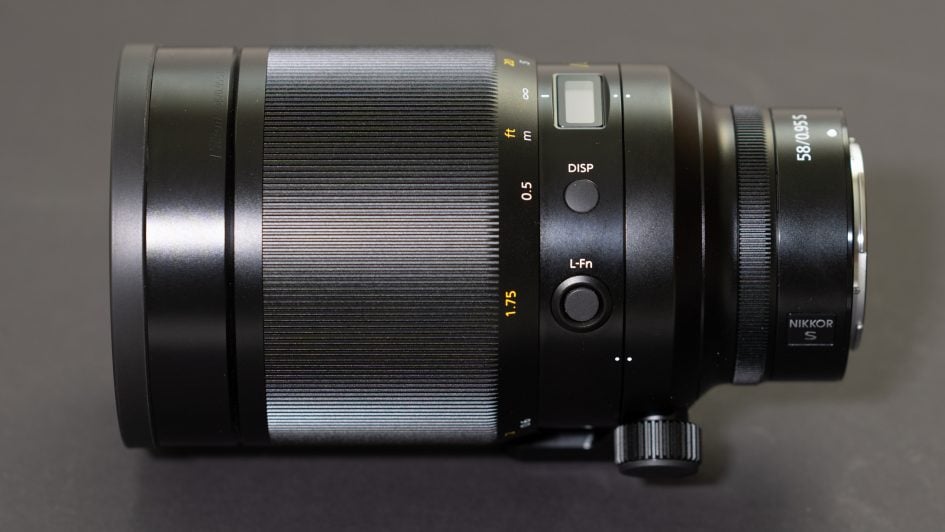
Facts from the catalog
As usual I’ll have a look at the technical data of the new Nikon Z 58mm f0.95 S Noct first. I’ve rated the features with a [+] (or [++]), when it’s better than average or even state of the art, a [0] if it’s standard or just average, and [-] if there’s a disadvantage. For this comparison I use the Nikon Z 50mm f1.8 S, Nikon AF-S 58mm f1.4G, Zeiss Otus 55mm f1.4 (“Otus” for short), and Zhongyi Mitakon Speedmaster 50mm f0.95 III (“Mitakon” for short).
Size (diameter x length): The Noct is a huge lens at 102 x 153mm (4.0 x 6.0in.) and the lens hood further adds 29mm to its length. The Z 50mm f1.8 S is much smaller at 76 x 87mm + 40mm for the lens hood. The Nikon AF-S 58mm f1.4G is 85 x 70mm + 44mm lens hood, the Otus 92 x 117mm + 32mm, the Mitakon 74 x 85mm + 32mm. For an apples-to-apples comparison one has to allow for the differences of flange distance between the Z-mount (16mm) and the F-mount (46.5mm). So these 30.5mm (1.2in.) have to be added when using the Nikon AF-S 58mm f1.4G or the Otus via FTZ adapter on a Nikon Z camera. [-]
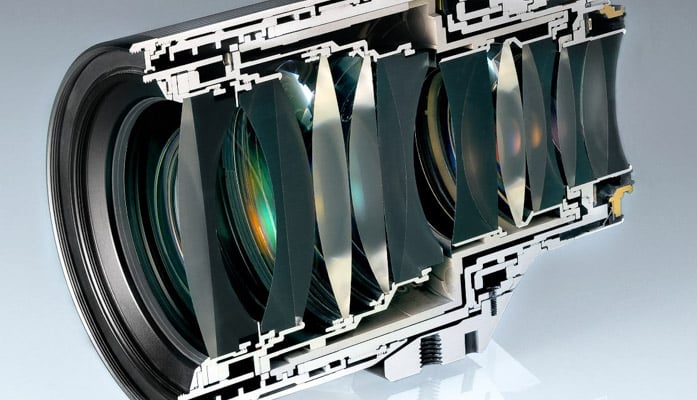
Weight: 1997g (70 oz.) including the non-detachable tripod mount plus 58g for the metal lens hood. This is extremely heavy even for a very solid all metal construction, double that of the already heavy Zeiss Otus. The weight together with its large diameter starts to impact handling when mounting the Noct on the camera. Better do it in reverse, mounting the camera on the lens. The Z 50mm f1.8 S is 412g + 27g for the lens hood. The Nikon AF-S 58mm f1.4G is 383g + 32g, the Otus 948g + 64g. Both need the FTZ adapter adding another 133g (4.7 oz.) for use on a Nikon Z camera. The Mitakon is 793g + 52g. [–]
Optics: 17 elements (including 4 special dispersion and 3 aspherical elements) in 10 groups which is the most complex standard lens-design I know of. The Z 50mm f1.8 S and the Otus have only 12 Elements, the Nikon AF-S 58mm f1.4G 9 lenses in 6 groups and the Mitakon 10/7. The new Nikon Z 58mm f0.95 S Noct employs fluorine coating on the front to repel water, dust, and dirt and should make for easier cleaning and uses Nikon’s new ARNEO coating (in addition to Nano coating) to reduce flare, glare and ghosting. [+]
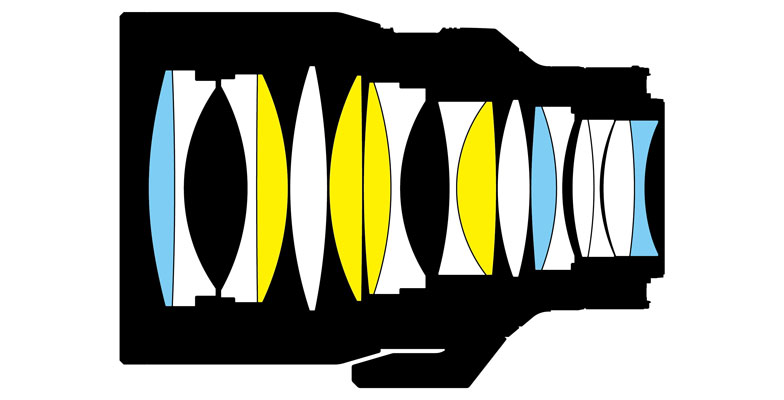
Closest focus distance is 0.5m (20in.) with a magnification of 1:4.9 and a working distance of 0.33m. A magnification of 1:10 is achieved at 0.79m. The Z 50mm f1.8 S goes down to 0.38m (15.0in.) with a magnification of 1:6. The Nikon AF-S 58mm f1.4G goes to 0.54m, the Otus 0.5m, the Mitakon 0.54m with magnifications of 1:7.2, 1:6.8, and 1:8.1 respectively. [+]
Filter-thread: The new Noct shares a 82mm filter-thread with the Nikon Z 14-30mm f4.0 S and the Nikon Z 24-70mm f2.8 S. The Z 50mm f1.8 S has 62mm, the Nikon AF-S 58mm f1.4G has 72mm, the Otus 77mm, the Mitakon 67mm. [0]
Image stabilization: The lens offers no optical stabilization – like every Z-Nikkor so far. But the Nikon Z bodies provide built-in sensor-shift stabilization for Z-mount lenses over 5 axis – plus an optional electronic stabilization in video mode. F-mount lenses without optical image stabilization like the Nikon AF-S 58mm f1.4G and the Otus profit from the body-based image stabilization of a Nikon Z body when used via FTZ adapter, but only over 3 axis (roll, pitch, yaw). [0]
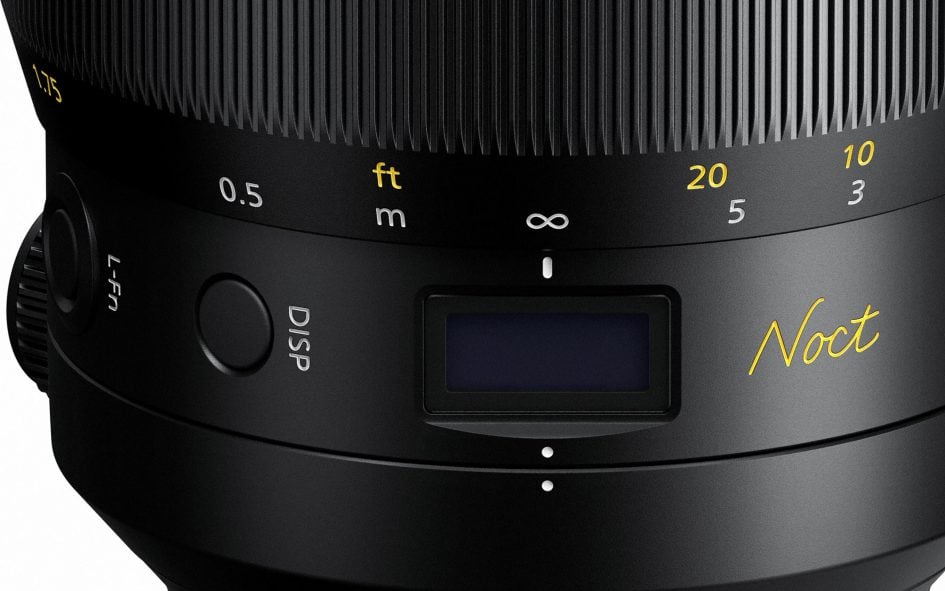
Auto focus: No, the new Noct is manual focus only, just like the Otus and the Mitakon. There’s a large mechanically coupled dedicated focus ring which turns 320 degrees for very precise manual focus. The focus ring has a linear gearing which makes smooth focus pulling for videographers easy. The same is true for the Mitakon except that it turns the Canon/Sony way. The Otus has a slightly shorter throw of 250 degrees and turns like Nikon users are used to. The Nikon Z 58mm f0.95 S Noct also features an OLED display indicating aperture or focusing distance (in m or ft.) and depth-of-field just like the Nikon Z 24-70mm f2.8 S. The display is hard to read under sunny conditions in its default setting but it can be made as bright as the top display on the Nikon Z camera. You can switch through the different display types using the DISP-button. There is also a function button L-Fn on the lens that is set to AE lock as default but can be assigned 21 different functions. Both the Z 50mm f1.8 S and the Nikon AF-S 58mm f1.4G offer autofocus. [-]
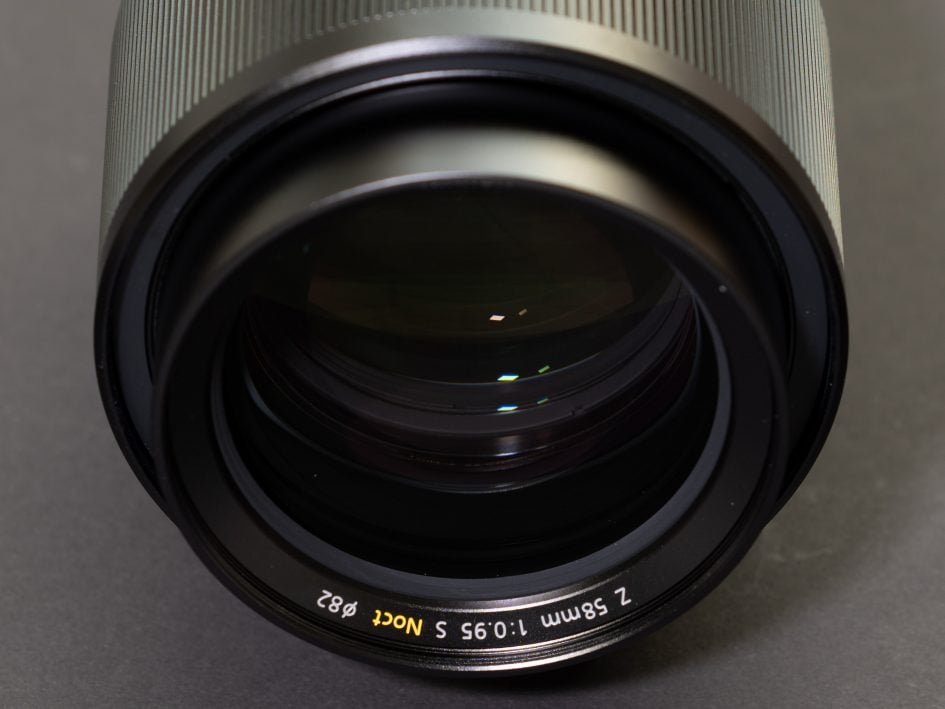
Lens profile: The lens comes with a lens profile just like the Z 50mm f1.8 S which can be controlled from the camera. Vignette control offers the usual options of High, Normal, Low and Off. Diffraction compensation and Auto distortion control can be activated or deactivated. While Adobe’s RAW converter ignores these settings and treats them as if they are set to Normal/On Nikon’s Capture NX-D allows to change the settings when developing RAWs. The Nikon AF-S 58mm f1.4G, Otus, and Mitakon do not come with a lens profile but Lightroom and Photoshop provide one with vignette and distortion control. [+]
Covers full frame/FX or smaller. Same with the alternatives. [+]
Price: The lens has a list price of 9000 EUR (incl. 19% VAT) / 8000 USD / 8300 GBP. So it’s even more expensive than the Otus (3200 EUR / 4000 USD) but that is easily explained by the larger focal ratio. The Leica Noctilux-M 50mm 0.95 ASPH is even selling north of 10,000 EUR. The Nikon AF-S 58mm f1.4G sells for 1600 EUR / 1450 USD, the Mitakon for 1000 EUR / 800 USD while the Z 50mm f1.8 S is clearly the cheapest at 400 EUR / 600 USD. [-]
Comes with a trunk case that protects the lens and has extra space for other accessories. Finally this is a case fitting for a lens costing 8000 USD unlike the flimsy pouch of the other Z lenses. But honestly: a well padded case like Sigma does for its equally humongous 105mm f1.4 Art would be more practical in my opinion. The tripod collar and the screw-on lens hood is included, the latter made from metal with a rubberized front segment to prevent dings and scratches from setting the lens down on the lens hood. But the hood is not reversible for transport and the lens cannot be stored in the case with the lens hood attached. The tripod collar has a slot for attaching an anti-theft cable chain lock but unfortunately Nikon missed out on an Arca-Swiss style interface. [+]
Trunk case for Nikon Z 58mm f0.95 S Noct with two “secret” compartments
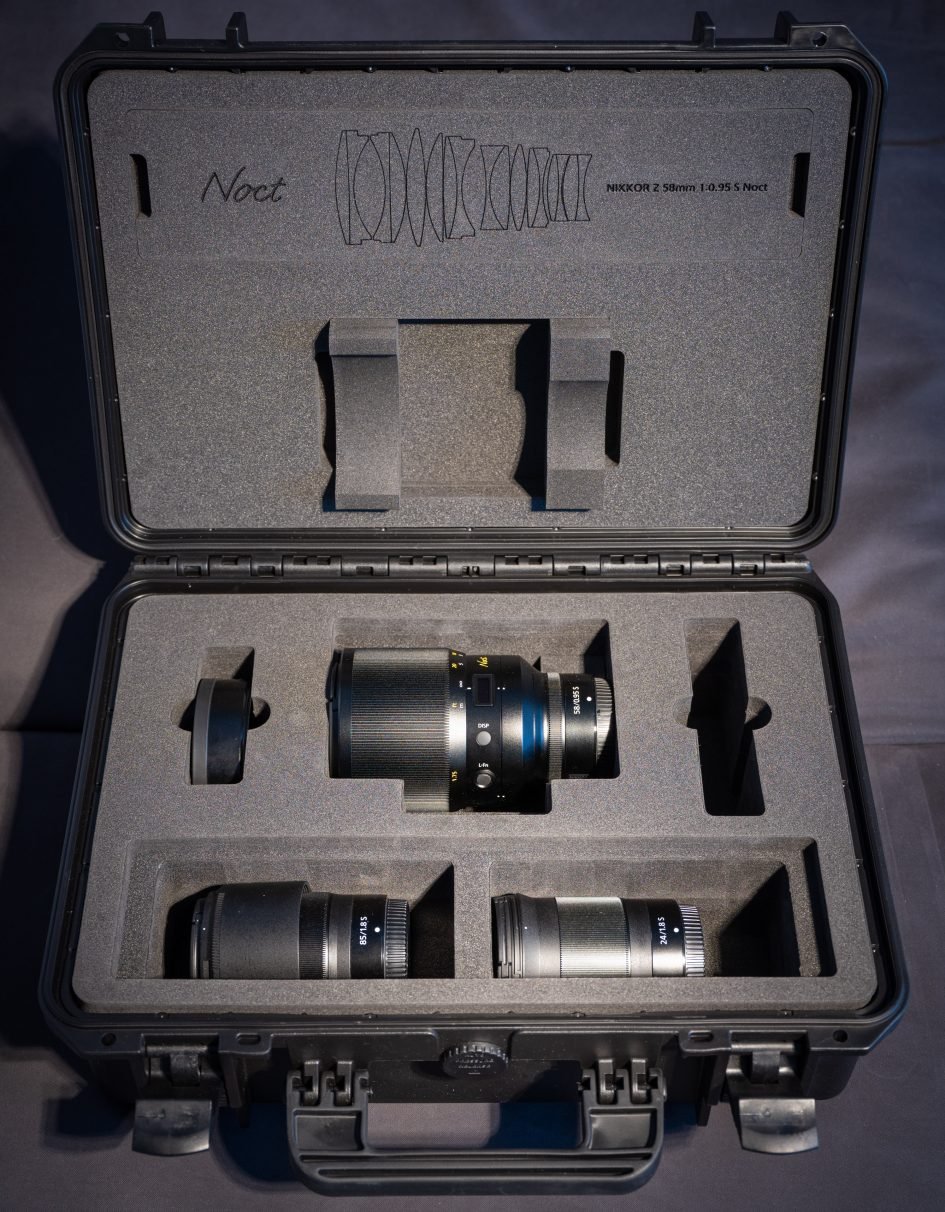
Above: Three Z-Nikkor lenses fit in the trunk case – but not the lens hood of the Z 24mm f1.8 S
Aperture ring: the multi-function control ring at the back of the Z 58mm f0.95 S Noct can be assigned to operate the aperture (this is the default) or exposure compensation. The aperture is actuated electromagnetically. The multi-function control ring on the Z 50mm f1.8 S can control aperture, exposure compensation or focusing. The Nikon AF-S 58mm f1.4G and most other F-mount alternatives don’t have an aperture control ring. The Zeiss Otus offers one (Nikon ZF.2 version only) but that is of no use as the Nikon Z cameras (unlike the D850) do not allow to control the aperture from there. The Mitakon has no electrical or mechanical coupling between the lens and the camera so aperture can only be controlled from the ring at the front of the lens. The ring has no clicks and can easily be moved accidentally. The Mitakon does not transfer EXIF data about the aperture (or focus distance) to the camera which means that you have to set exposure manually and the aperture is not recorded in the image-file. [+]
Sealing: yes, a rubber grommet at the lens-mount plus further special weather-sealing throughout the construction just like the Z 50mm f1.8 S. The Nikon AF-S 58mm f1.4G only has the sealing at the lens-mount, the Otus and Mitakon not even that. [+]
Adding another [++] for the unique focal ratio of f0.95 the score in the “features-department” of the new Noct is 5[-]/2[0]/9[+]. The downsides to this lens: It’s extra large and extremely heavy, has no autofocus and is even more expensive than any Zeiss Otus. So Nikon’s new lens which showcases the possibilities of their Z mount better deliver on the promise of a unique photographic experience.
Five standard prime lenses for Nikon
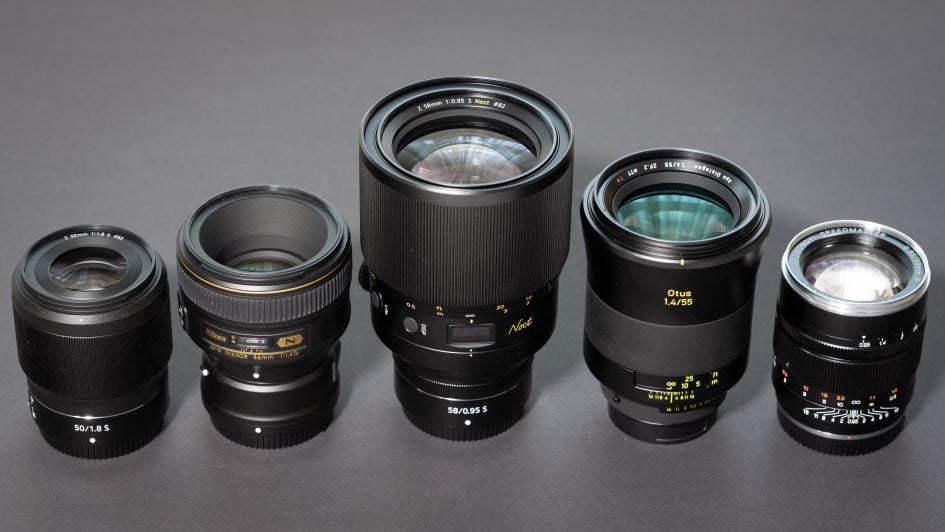
Above from left to right: Nikon Z 50mm f1.8 S, Nikon 58mm f1.4G on Nikon FTZ adapter, Nikon Z 58mm f0.95 S Noct, Zeiss Otus 55mm f1.4 (needs FTZ adapter) and Mitakon Speedmaster 50mm f0.95 III
Alternatives
The market for standard prime lenses is pretty crowded and some manufacturers even offer (or have announced) 50mm f0.95 full-frame lenses namely Leica (for M-mount, around 10,000 EUR), Meyer Optik (for E-mount, 1500 EUR) and Mitakon (E-, RF- and Z-mount) – all of which are manual focus only. Let’s have a closer look at the Mitakon:
- The Zhongyi Mitakon Speedmaster 50mm 0.95 III was announced in June 2019 and seems to be available now for Z-mount too. It is much smaller and lighter than the new Nikon Noct at 73 x 84mm and 720g (without lens hood). Its priced 1000 EUR / 800 USD. The lens does not have any electric contacts so the aperture has to be closed manually to the desired value and there are no EXIF-data nor lens-profiles being transmitted to the camera.
For shooters of Nikon Z cameras the alternatives also include F-mount lenses which can be used mounted on Nikon’s FTZ adapter – adding another 31mm in length and 133g in weight:
- Nikon offers the only f1.2 lens of the alternatives, the Nikon 50mm f1.2 Ai-S from 1981. This lens is not to be confused with the famed Noct-Nikkor 58mm f1.2 which is no longer in production. The 50mm f1.2 is manual focus only and goes for 700 EUR / 600 USD.
- Nikon also offers two autofocus alternatives with a focal ratio of f1.4: the AF-S 50mm f1.4G from 2008 (410 EUR/USD) and the AF-S 58mm f1.4G from 2013 (1600 EUR / 1450 USD).
- Sigma offers the AF 50mm f1.4 DG HSM Art from 2014 for 700 EUR / 950 USD. See my Sigma 50mm f1.4 Art review where it came Highly Recommended. The Sigma Art is also a big and heavy lens although not as extreme as the new Noct. Still: mounting it on the FTZ adapter the Sigma Art has a diameter of 85mm, a length of 130mm and a weight of 950g (w/o lens hood).
- The Zeiss Otus 55mm f1.4 from 2015 is my current reference standard prime lens. But it costs 3200 EUR / 4000 USD – and it’s manual focus only, just like the new Noct. But its build quality is as yet unsurpassed and the optical performance is top notch. It earned a Highly Recommended in my Zeiss Otus 55mm f1.4 review.
- There is also the Planar 50mm f1.4 and the Milvus 50mm f1.4 from Zeiss. Both are manual focus only costing around 650 EUR / 1100 EUR respectively.
- Samyang has the manual focus 50mm f1.4 AS UMC from 2015 which costs 430 EUR / 400 USD.
How big are the differences between 50mm and 58mm focal length? Here is the angle of view that the Nikon Z 58mm f0.95 S Noct covers on a full-frame body compared to the Mitakon 50mm f0.95 III:

Above: Nikon Z 58mm f0.95 S Noct (left), Mitakon 50mm f0.95 III (right)
Focus
As with all manual focus lenses I can only say: if you can’t manage to properly focus manually you better forget about this lens – and at f0.95 that is an even more daunting task. But the Nikon Z cameras offer focus peaking and a magnified viewfinder which makes it easy to focus precisely. It just takes more time and your target shouldn’t move.
The focus ring is 57mm wide and has no slack/play between its movement and the focus-action and a throw of 320 degrees, which is ideal for accurate focus wide open. At the minimum object distance of 0.5m the inner barrel of the lens extends 21mm over the retracted status at infinity. The focus ring moves stiffly and cannot be operated with one finger. The Mitakon runs a bit smoother but is still hard to operate with one finger while the Zeiss Otus has an excellent silky smooth operation. All those manual focus lenses have hard stops on both sides of the distance scale so you know exactly when you’ve reached one or the other end of the focus range. But the hard stop on the far end is a bit beyond infinity so you star-gazing photographers still need to find exact focus manually if you want to capture the Milky Way in all its sparkling glory.
As you pull focus, you’ll notice quite some focus breathing: the image of the Nikon Z 58mm f0.95 S Noct becomes 16% more magnified when I adjusted the focus from infinity to 0.79m. This is very visible and a disappointment for videographers. And it is stronger than from the other lenses: The Mitakon breathes 11%, Nikon 58mm f1.4G 10%, Zeiss Otus 5%, Nikon Z 50mm f1.8 S -1%.
Prime time: Some of the biggest prime lenses for full-frame cameras
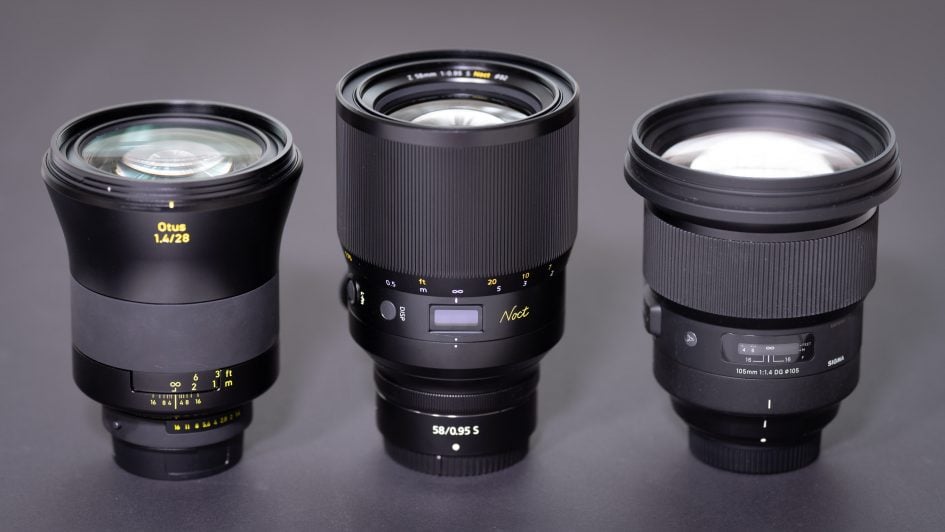
Above from left to right: Zeiss Otus 28mm f1.4, Nikon Z 58mm f0.95 S Noct, Sigma 105mm f1.4 Art
Next check out my quality results!
Check prices on the Nikon Z 58mm f0.95 Noct at B&H, Adorama, or Wex. Alternatively get yourself a copy of my In Camera book or treat me to a coffee! Thanks!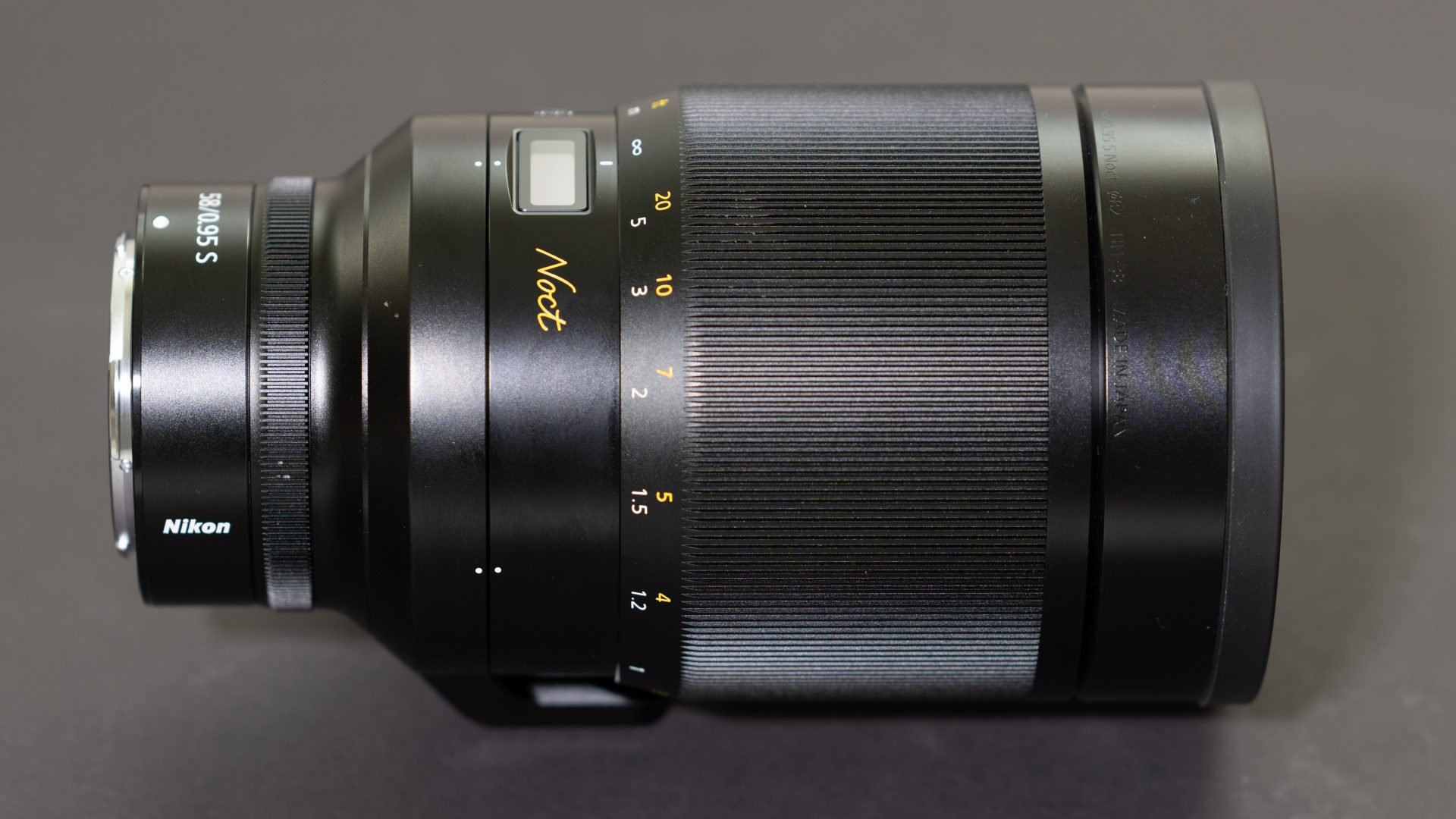
 The Nikon Z 58mm f0.95 S Noct is an extraordinary lens: It combines an extra large f0.95 focal ratio with excellent optical performance, even surpassing the Zeiss Otus and the best Bokeh I've seen so far in a prime lens up to 85mm focal length. You might not need the f0.95 aperture but when you use this lens you can produce images that are hard to duplicate with any other model. For these special occasions the Nikon Z 58mm f0.95 S Noct is a unique lens with the best available performance. As such it clearly deserves a Highly Recommended although it's extremely heavy and expensive, and manual focus only.
The Nikon Z 58mm f0.95 S Noct is an extraordinary lens: It combines an extra large f0.95 focal ratio with excellent optical performance, even surpassing the Zeiss Otus and the best Bokeh I've seen so far in a prime lens up to 85mm focal length. You might not need the f0.95 aperture but when you use this lens you can produce images that are hard to duplicate with any other model. For these special occasions the Nikon Z 58mm f0.95 S Noct is a unique lens with the best available performance. As such it clearly deserves a Highly Recommended although it's extremely heavy and expensive, and manual focus only.



